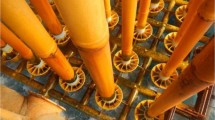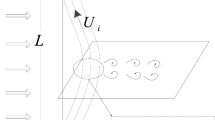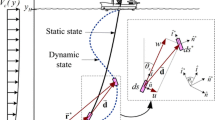Abstract
The purpose of this research is to present the mathematical model for the nonlinear vibration analysis of a deepwater catenary riser subjected to a wave excitation. The mathematical model of the catenary riser is derived from the work-energy principle, including the geometrical nonlinearity and nonlinear loading from a square drag term of hydrodynamic force. The finite element method is used to form the equation of motion for solving the numerical solution. The nonlinear equation of motion can be written in the appropriate form, which is convenient to perform the numerical integration. The Newmark time integration incorporated direct iteration is used to solve the nonlinear vibration response of the catenary riser. The nonlinear forced vibration analysis is carried out for both small and large vibration amplitudes. From numerical investigation, it was found that the vibration response of the riser due to wave force is a harmonic motion and the vibration amplitude increases as the increasing in wave amplitude. In addition, the effect of nonlinear geometry has a significant influence on the vibration amplitude of the riser.
Access this chapter
Tax calculation will be finalised at checkout
Purchases are for personal use only
Similar content being viewed by others
References
Athisakul, C., Klaycham, K., Chucheepsakul, S.: Critical top tension for static equilibrium configuration of a steel catenary riser. China Ocean Eng. 28(6), 829–842 (2014). https://doi.org/10.1007/s13344-014-0064-x
Cheng, Y., Ji, C., Zhai, G., Oleg, G.: Nonlinear analysis for ship-generated waves interaction with mooring line/riser systems. Mar. Struct. 59, 1–24 (2018)
Chucheepsakul, S., Monprapussorn, T.: Nonlinear buckling of marine elastica pipes transporting fluid. Int. J. Struct. Stab. Dyn. 1(3), 333–365 (2001)
Chucheepsakul, S., Monprapussorn, T., Huang, T.: Large strain formulations of extensible flexible marine pipes transporting fluid. J. Fluids Struct. 17(2), 185–224 (2003)
Chucheepsakul, S., Huang T.: Natural frequencies of a marine riser in three-dimensions. In: Proceedings of the 7th International Offshore Mechanics and Arctic Engineering Symposium, pp. 651–658 (1989)
Cook, R.D., Malkus, D.S., Plesha, M.E.: Concept and Applications of Finite Element Analysis, 4th edn. Wiley, New York, USA (2002)
Duanmu, Y., Zou, L., Wan, D.: Numerical analysis of multi-modal vibrations of a vertical riser in step currents. Ocean Eng. 152, 428–442 (2018)
Kaewunruen, S., Chiravatchradej, J., Chucheepsakul, S.: Nonlinear free vibrations of marine risers/pipes transporting fluid. Ocean Eng. 32(3–4), 417–440 (2005)
Klaycham, K., Athisakul, C., Chucheepsakul, S.: Large amplitude vibration of a deepwater riser conveying oscillatory internal fluid flow. Ocean Eng. 217, 107966-1–108015 (2020)
Lei, S., Zhang, W., Lin, J., Yue, Q., Kennedy, D., Williams, F.W.: Frequency domain response of a parametrically excited riser under random wave forces. J. Sound Vib. 333(2), 485–498 (2014)
Mazzilli, C.E.N., Rizza, F., Dias, T.: Heave-imposed motion in vertical risers: A reduced-order modelling based on Bessel-like modes. Procedia IUTAM 19, 136–143 (2016)
Meng, S., Song, S., Che, C., Zhang, W.: Internal flow effect on the parametric instability of deepwater drilling risers. Ocean Eng. 149, 305–312 (2018)
Montoya-Hernández, D.J., Vázquez-Hernández, A.O., Cuamatzi, R., Hernandez, M.A.: Natural frequency analysis of a marine riser considering multiphase internal flow behavior. Ocean Eng. 92, 103–113 (2014)
Morison, J.R., O’Brien, M.P., Johnson, J.W., Schaaf, S.A.: The force exerted by surface waves on piles. Petrol. Trans. Am. Inst. Min. Eng. 189, 149–154 (1950)
Newmark, N.M.: A method of computation for structural dynamics. J. Eng. Mech. Div. ASCE 85(3), 67–94 (1959)
Paidoussis, M.P.: Fluid Structure Interaction: Slender Structure and Axial Flow, vol. 1. Academic, London (1998)
Punjarat, O., Chucheepsakul, C.: Nonlinear formulation and free vibration of a large-sag extensible catenary riser. Ocean Syst. Eng. 11(1), 59–81 (2021)
Sparks, C.P.: Fundamentals of Marine Riser Mechanics: Basic Principles and Simplified Analyses. Pennwell Corporation, Oklahoma, USA (2007)
Takafuji, F.C.M., Martins, C.A.: Comparison between frequency domain and time domain riser analysis. J. Offshore Mech. Arct. Eng. 134(4), 041301–041309 (2012)
Vásquez, J.A.M., Avila, J.P.J.: A parametric analysis of the influence of the internal slug flow on the dynamic response of flexible marine risers. Ocean Eng. 174, 169–185 (2019)
Wang, J., **ang, S., Fu, S., Cao, P., Yang, J., He, J.: Experimental investigation on the dynamic responses of a free-hanging water intake riser under vessel motion. Mar. Struct. 50, 1–19 (2016)
Zhang, L., et al.: Axial and transverse coupled vibration characteristics of deep-water riser with internal flow. Procedia Eng. 126, 260–264 (2015)
Acknowledgements
The authors gratefully acknowledge the funding provided by the Department of Civil Engineering, Faculty of Engineering at Kamphaeng Saen, Kasetsart University, and the support from Thailand Research and Innovation under Fundamental Fund 2022 (Advanced Construction Towards Thailand 4.0 Project) to the Construction Innovations and Future Infrastructures Research Center at the King Mongkut’s University of Technology Thonburi.
Author information
Authors and Affiliations
Corresponding author
Editor information
Editors and Affiliations
Appendix A
Appendix A
According to Eq. (16), the linear element stiffness matrix \(\left[{{\varvec{k}}}_{L}\right]\) can be calculated by
where the linear element bending stiffness matrix \(\left[ {{}_{b}^{{}} {\varvec{k}}_{L} } \right]\) and the linear element axial stiffness matrix \(\left[ {{}_{a}^{{}} {\varvec{k}}_{L} } \right]\) are
The first-order nonlinear element stiffness matrix \(\left[ {{\varvec{k}}_{N1} } \right]\) resulting from the nonlinear geometric is
and the second-order nonlinear element stiffness matrix \(\left[ {{\varvec{k}}_{N2} } \right]\) is
The parameters \(\alpha\) and \(\beta\) in Eqs. (A.4) and (A.5) are defined as follows.
The matrices \(\left[ {\varvec{m}} \right]\), \(\left[ {\varvec{g}} \right]\), and \(\left[ {{\varvec{k}}_{i} } \right]\) in Eq. (17) are the element mass matrix, element gyroscopic matrix, and element centrifugal force matrix, respectively. These matrices can be expressed as follows.
The matrices \(\left[ {{\varvec{m}}_{a} } \right]\), \(\left[ {\varvec{c}} \right]\), and \(\left\{ {\varvec{f}} \right\}\) in Eq. (18) are the element added mass matrix, the element hydrodynamic dam** matrix, and the element hydrodynamic excitation vector, respectively. These matrices can be expressed as follows.
Rights and permissions
Copyright information
© 2023 The Author(s), under exclusive license to Springer Nature Singapore Pte Ltd.
About this paper
Cite this paper
Lertchanchaikun, N., Klaycham, K., Athisakul, C., Chucheepsakul, S. (2023). Nonlinear Vibrations of Deepwater Catenary Riser Subjected to Wave Excitation. In: Geng, G., Qian, X., Poh, L.H., Pang, S.D. (eds) Proceedings of The 17th East Asian-Pacific Conference on Structural Engineering and Construction, 2022. Lecture Notes in Civil Engineering, vol 302. Springer, Singapore. https://doi.org/10.1007/978-981-19-7331-4_65
Download citation
DOI: https://doi.org/10.1007/978-981-19-7331-4_65
Published:
Publisher Name: Springer, Singapore
Print ISBN: 978-981-19-7330-7
Online ISBN: 978-981-19-7331-4
eBook Packages: EngineeringEngineering (R0)




